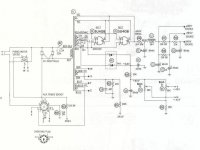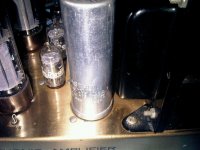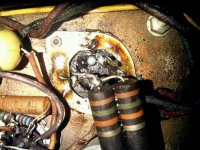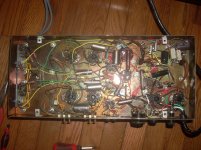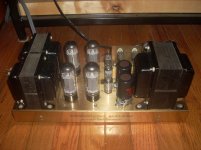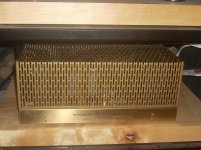I just traded a turntable for a Pilot SA-260 amp and a Fisher 400C pre amp. Both are in great condition. I've ordered a variac to bring both up slowly. Any advise on what to look for/watch out for specifically with the SA-260? I plan to do what's needed with that one to use in my system. It has 4 EL34 brown bottom Mullards and I'm hoping there's still some good life left in them.
The variac is a GOOD idea, but you really should replace all the old and literally dried out electrolytic capacitors before using the variac.
The SA-260 schematic can be found here, a bit more than 1/2 way down the page.
The bias rectifier (shown as M1) is almost certainly selenium, which makes it a ticking toxic time bomb. Replace that item with a pair of 200 PIV/1 A. Schottky diodes.
As long as you don't use the amp to power a preamp, it's pretty safe to replace the non-linear 12AU7 with a linear 12BH7.
I agree in using the Mullard EL34s, until they wear out. When replacement becomes necessary, purchase a set of "reissue" GEC KT77s. The Saratov, Russia, made KT77s are the best EL34 class tube currently being manufactured.
Unless they are damaged, leave the grid stopper resistors be, as carbon composition in those positions is very good. OTOH, carbon comp. parts elsewhere can be problematic, due to noise and drift. Metal film parts are low noise and well suited to the grid to ground role. Carbon film parts replace carbon comp. everywhere else.
Unless they are damaged, don't mess with wirewound resistors.
The signal caps. too are candidates for replacement. FWIW, I would use Soviet surplus paper in oil (PIO) parts outside the NFB loop and 716P series "Orange Drops" inside the NFB loop.
The SA-260 schematic can be found here, a bit more than 1/2 way down the page.
The bias rectifier (shown as M1) is almost certainly selenium, which makes it a ticking toxic time bomb. Replace that item with a pair of 200 PIV/1 A. Schottky diodes.
As long as you don't use the amp to power a preamp, it's pretty safe to replace the non-linear 12AU7 with a linear 12BH7.
I agree in using the Mullard EL34s, until they wear out. When replacement becomes necessary, purchase a set of "reissue" GEC KT77s. The Saratov, Russia, made KT77s are the best EL34 class tube currently being manufactured.
Unless they are damaged, leave the grid stopper resistors be, as carbon composition in those positions is very good. OTOH, carbon comp. parts elsewhere can be problematic, due to noise and drift. Metal film parts are low noise and well suited to the grid to ground role. Carbon film parts replace carbon comp. everywhere else.
Unless they are damaged, don't mess with wirewound resistors.
The signal caps. too are candidates for replacement. FWIW, I would use Soviet surplus paper in oil (PIO) parts outside the NFB loop and 716P series "Orange Drops" inside the NFB loop.
Thanks for the help. I am finding a lot of NOS multi Can Caps but none that match the C1 and C2 for the 260.
According to the linked chassis layout, the caps are singles, not multi's.
jeff
Unless you're very careful, it's easy to get stuck with 'lytics that are not fresh. NOS dries out sitting on the shelf. 
For the convenience of other posters and yours truly, I've uploaded an extract of the SA-260 PSU.
Pilot was VERY conservative in the way they stressed the pair of 5U4GB rectifiers. That allows some room for tweaking. For instance, 50 μF. for C1A and 100 μF. for C1B will be quite safe. Let's see what we can come up with in the way of multi-section parts known to be fresh, in both twist-lock and clamp mounted versions. I hope a little drilling is not beyond you. Measure the EOM parts' diameter. Then, check out the offerings of Jim McShane. While Jim is not the only game in town, his prices are fair and he doesn't spout BS.
That allows some room for tweaking. For instance, 50 μF. for C1A and 100 μF. for C1B will be quite safe. Let's see what we can come up with in the way of multi-section parts known to be fresh, in both twist-lock and clamp mounted versions. I hope a little drilling is not beyond you. Measure the EOM parts' diameter. Then, check out the offerings of Jim McShane. While Jim is not the only game in town, his prices are fair and he doesn't spout BS.
Another technique for obtaining cap. mounting "real estate" is to place a piece of perf. board, using standoffs, on the power trafo mounting bolts.
For the convenience of other posters and yours truly, I've uploaded an extract of the SA-260 PSU.
Pilot was VERY conservative in the way they stressed the pair of 5U4GB rectifiers.
Another technique for obtaining cap. mounting "real estate" is to place a piece of perf. board, using standoffs, on the power trafo mounting bolts.
Attachments
I should be receiving my replacement can caps today. I was trying to get ready for them last night and have a question about how to remove the old cans before I tear something up. How do you remove the old cans? Do I have to drill out the old rivets? Or continue to try and wick out the old solder on two outer tabs that really don't appear to be holding the can in?
I believe you have clamp mount replacements. So, knock the rivets out and use desoldering braid to clean the twist-lock tabs up. Untwist the tabs and get everything, including the old carbon comp. resistors out of there. Install equal value modern carbon film parts of the same or higher dissipation rating. Carbon comp. resistors drift and go noisy, with the passage of time. The problem is more acute in parts rated for 1 W. and higher.
Thanks Eli, well this turned into a project. I didn't test the tubes first and it appears all 4 of the EL34s were bad. I've tested them now and they are all bad, I'll never know if I fried them or they were bad in the first place. After replacing the caps and turning it on there was higher than expected voltage everywhere. I did have a speaker load connected. After 3-4 minutes of the amp being on, one of the output transformer wires burned. That's been fixed by TRS. Jim McShane introduced me to Don Sachs. Jim is putting together a kit for Don to rebuild the whole amp.
I received my amp back from Don Sachs. He replaced all of the signal path resistors and caps, all parts and Mullard EL34 reissues from Jim McShane. Rebuilt the entire power supply and made a modification to the input stage. Don redesigned the input circuit from the 12AU7 to accomodate a 6CG7. To say I am pleased with the outcome is a gross understatement. This thing sounds incredible. I will post some pictures later.
- Status
- This old topic is closed. If you want to reopen this topic, contact a moderator using the "Report Post" button.
- Home
- Amplifiers
- Tubes / Valves
- Pilot SA-260 amp and Fischer 400C advice
